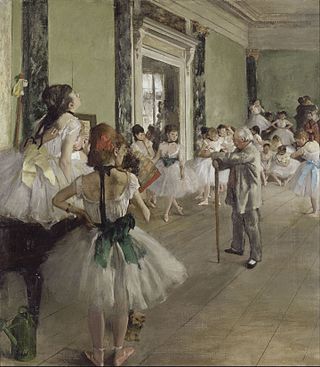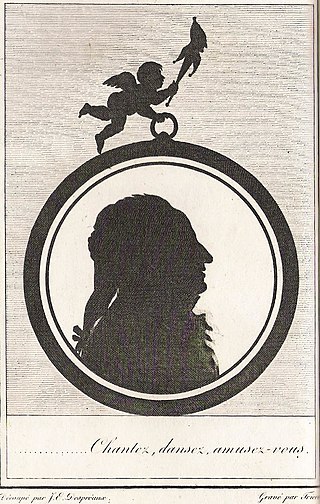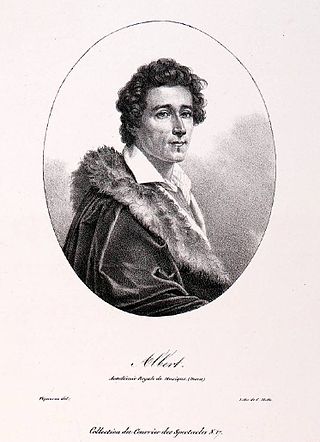Related Research Articles

The Royal Danish Ballet is an internationally renowned classical ballet company, based at the Royal Danish Theatre in Kongens Nytorv, Copenhagen, Denmark. It is one of the oldest ballet companies in the world and originates from 1748, when the Royal Danish Theatre was founded. It was finally organized in 1771 in response to the great popularity of French and Italian styles of dance. The company was founded with the opening of the Royal Danish Theatre, which has served as its home since that time. The Royal Danish Ballet school was founded in 1771 under the leadership of French ballet teacher Pierre Laurent (1730–1807), then Vincenzo Galeotti developed it and August Bournonville founded his methodology for the school.

Charles Simon Favart was a French playwright and theatre director. The Salle Favart in Paris is named after him.

Charles Felix Richard Auguste Le Picq was an influential French dancer and choreographer. One of the most outstanding dancers of the eighteenth century.

A ballet master is an employee of a ballet company who is responsible for the level of competence of the dancers in their company. In modern times, ballet masters are generally charged with teaching the daily company ballet class and rehearsing the dancers for both new and established ballets in the company's repertoire. The artistic director of a ballet company, whether a male or female, may also be called its ballet master. Historic use of gender marking in job titles in ballet is being supplanted by gender-neutral language job titles regardless of an employee's gender.

François van Campenhout was a Belgian opera singer, conductor and composer. He composed the music for the Belgian national anthem, "La Brabançonne".

Jean-Étienne Despréaux was a French ballet dancer, choreographer, composer, singer and playwright.
Suzette Defoye née Marie-Suzanne-Joséphe Artus Truyart, was a French ballet dancer, stage actor, opera singer and theatre director, active in France, Belgium and Russia.
Alexandre Bultos was a comic actor and theatre director from the Austrian Netherlands in the Holy Roman Empire.
Joseph Hansen was a Belgian dancer and choreographer. He was maître de ballet of the Paris Opera Ballet from 1887 to 1907.

Jean-Antoine-Nicolas Petipa was a French ballet dancer and the father of Marius Petipa.
Pierre-Louis Stapleton was a ballet dancer and choreographer, born in the Austrian Netherlands who worked in France and the Netherlands. He was also known from around 1759 by the pseudonym Eugène Hus, after his stepfather Jean-Baptiste Hus.

François-Ferdinand Decombe was a French ballet dancer and ballet master, under the stage name Albert.
Françoise Adret was a French ballet dancer, teacher, choreographer, and company director.

Neoclassical architecture appeared in Belgium during the period of Austrian occupation in the mid-18th century and enjoyed considerable longevity in the country, surviving through periods of French and Dutch occupation, and the birth of Independent Belgium, surviving well into the 20th century.
Louis-Aimé d'Auvigny was an 18th-century French dancer, ballet master, choreographer, and dance teacher.

Alexandre-Frédéric-Jacques Masson, marquis de Pezay, was an 18th-century French soldier, courtier and man of letters.
Louis Frossard was an 18th-century French dancer who conducted part of his career in Sweden.

Charles, Knight Vandenhove was one of the leading Belgian architects of the 20th century. His company Charles Vandenhove et associés is based in Liège, Belgium. He is mostly known for his work in Belgium, the Netherlands and Paris ranging from the 1950s to the 2010s.

Andries Cornelis Lens or André Corneille Lens was a Flemish painter, illustrator, art theoretician and art educator. He is known for his history paintings of biblical and mythological subjects and portraits. Wishing to contribute to the revival of painting in Flanders, he took his inspiration from the classical traditions of the 16th century and drew inspiration from Raphael. He was thus a promoter of Neoclassicism in Flemish art. He was a teacher and director of the Academy of Fine Arts of Antwerp. Lens was court painter to the governor-general of the Austrian Netherlands and settled in Brussels where he married. Lens was also a writer and historian who published an illustrated book which discussed the costumes, ornaments and furnishings of the various people in Antiquity and another book setting out his art theories.

Charles-Louis-Joseph Hanssens, known under the name Hanssens the elder, was a Belgian violinist, composer, conductor and theatre director.
References
- Jean-Philippe Van Aelbrouck, Bernardy, Charles-Alexandre Bernard, dit Bernardy, in Dictionnaire des danseurs, Editions Mardaga, 1994, p. 71-74.